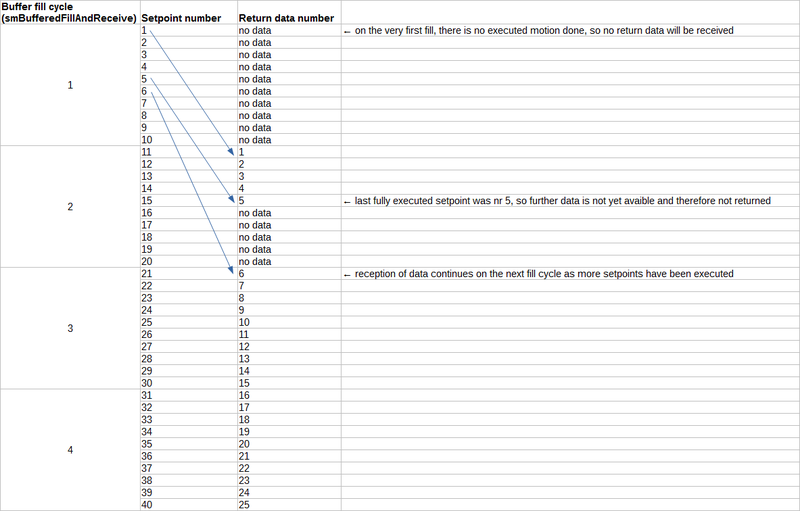Difference between revisions of "Buffered motion stream in SimpleMotion V2"
From Granite Devices Knowledge Wiki
| [checked revision] | [checked revision] |
(Created page with "The buffered motion stream feature of SimpleMotion V2 bus allows implementing multi-axis motion control applications without need of real-time host or motion controller. T...") |
(Tag: VisualEditor) |
||
| Line 1: | Line 1: | ||
| − | The buffered motion stream feature of [[SimpleMotion V2]] bus allows implementing multi-axis motion control applications without need of real-time host or motion controller. The principle behind this mode is two-way FIFO buffers inside the drives which allow | + | The buffered motion stream feature of [[SimpleMotion V2]] bus allows implementing multi-axis motion control applications without need of real-time host or motion controller. The principle behind this mode is two-way FIFO buffers inside the drives which allow buffering upcoming motion commands as well as return data (user selectable parameter to read/monitor during motion). |
| − | == | + | ==Buffered motion stream characteristics== |
===Pros=== | ===Pros=== | ||
*Allow synchronizing multiple axes and running arbitrary motion paths | *Allow synchronizing multiple axes and running arbitrary motion paths | ||
| Line 16: | Line 16: | ||
==Data flow== | ==Data flow== | ||
Each sent [[setpoint]] value will produce a return data point. Return data is user selectable and may contain for example position feedback value. It should be noted that reception of return data is delayed and read after drive has executed the corresponding setpoint commands. | Each sent [[setpoint]] value will produce a return data point. Return data is user selectable and may contain for example position feedback value. It should be noted that reception of return data is delayed and read after drive has executed the corresponding setpoint commands. | ||
| − | {{picturebox|buffered data flow.png|caption=Data flow in buffered motion stream}} | + | {{picturebox|buffered data flow.png|caption=Data flow in buffered motion stream. Note: the sequential numbers represent the '''index''' of the setpoint/returned data points, not the actual values.}} |
[[Category:CNC]] | [[Category:CNC]] | ||
Revision as of 19:36, 6 October 2016
The buffered motion stream feature of SimpleMotion V2 bus allows implementing multi-axis motion control applications without need of real-time host or motion controller. The principle behind this mode is two-way FIFO buffers inside the drives which allow buffering upcoming motion commands as well as return data (user selectable parameter to read/monitor during motion).
Buffered motion stream characteristics
Pros
- Allow synchronizing multiple axes and running arbitrary motion paths
- Motion acceleration and velocity profiles are generated by user application
- Unlimited trajectory duration
- Typical setpoint update rates are 250 Hz to 1000 Hz for 1 to 4 axis systems
Cons
- Delay caused by buffering (0.2-1.0 sec buffering is recommended to avoid buffer underruns and breaks of motion)
- Update rate will reduce as more axes are added to the system (due to bus bandwidth limit)
- Some added complexity in programming
For alternative methods, see SimpleMotion motion control strategies
Data flow
Each sent setpoint value will produce a return data point. Return data is user selectable and may contain for example position feedback value. It should be noted that reception of return data is delayed and read after drive has executed the corresponding setpoint commands.
